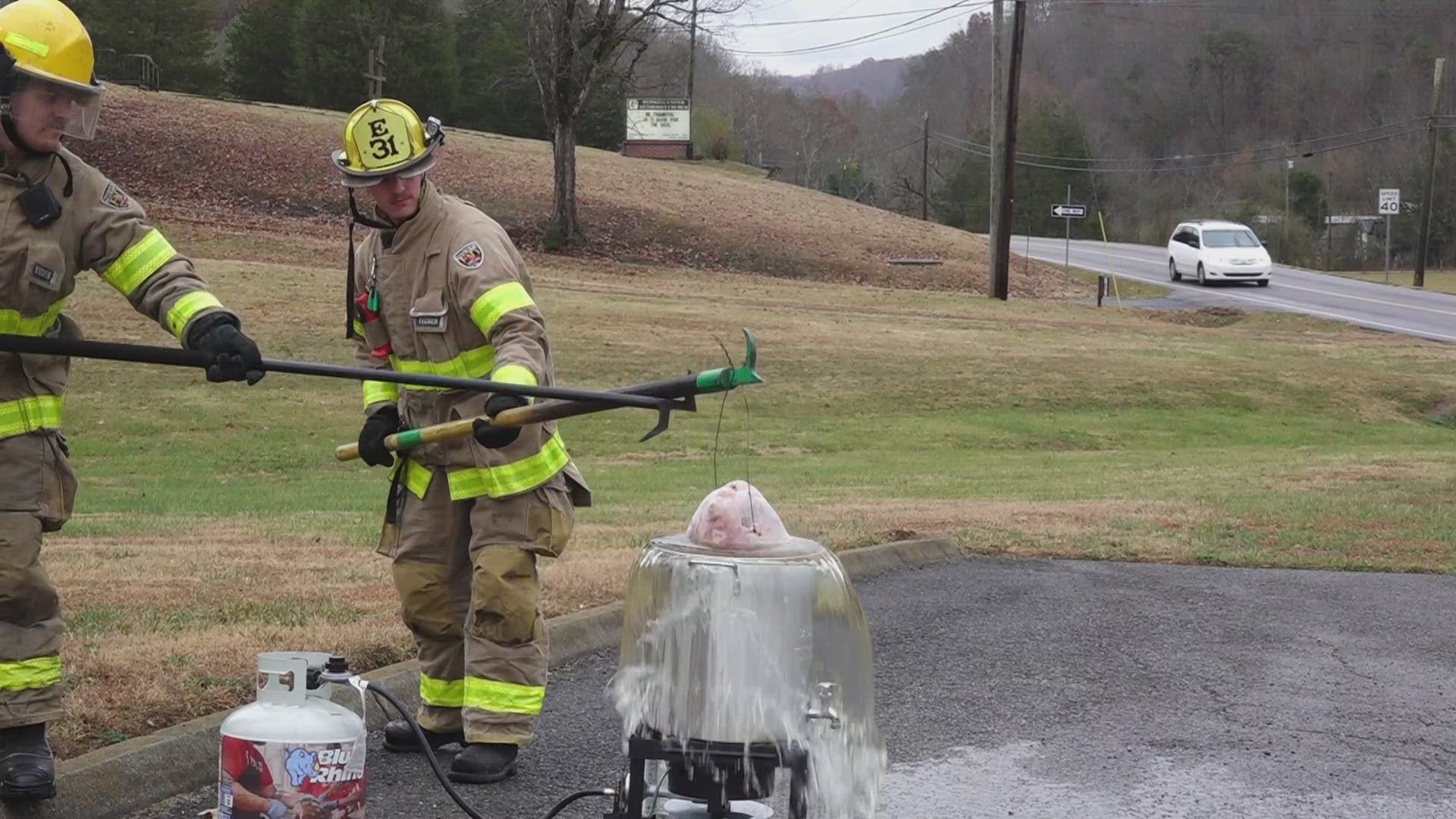KNOXVILLE, Tenn. — Thanksgiving is a time when many families come together, but it's also a time when some people's safety and health can be put at risk.
According to the U.S. Fire Administration, from 2017 to 2019, an average of 2,300 residential building fires were reported to fire departments on Thanksgiving Day. Rural Metro Fire held a demonstration of what could happen if families deep fry their turkeys incorrectly.
Jeff Bagwell, the public information officer of the department, said common mistakes include using frozen turkeys, using too much oil and having the temperature too high.
"That's one of the biggest safety things, is to make sure that the turkey is completely thawed before we put it in the oil," said Bagwell. "And then the other thing is to make sure that the oil level is at the right level in the pot, there is a mark on the pot that tells you exactly where to fill the oil."
For the purpose of the demonstration, he said the department didn't follow the proper protocol. He said it was to show the dangers of not following the rules.
"On the temperature gauge, there is a red zone where you don't want the temperature to go," said Bagwell. "And that's where we're going to put it, but that's not where we want you to do it at home. We want you to see what can happen when you go too far. And when you exceed those safety parameters that are put in place."
When firefighters dipped the turkey into the overheated and overfilled frying vat, it burst into flames, warning it could happen at families' homes. He said a fire could not only burn people but could also damage or destroy homes.
Bagwell wants to remind people who are deep frying a turkey to do it on concrete or asphalt and stay away from grass, leaves or anything else that could burn.
Fires aren't the only safety risk families may be faced with on Thanksgiving. If someone is sick, they could spread germs by preparing and cooking food.
"Make sure that you are working only when you're feeling well. If you're not feeling well, do not work with food," said Camila Almeida, an environmental specialist for the Knox County Health Department. "Specifically, we're looking at vomiting and diarrhea. We have an increase in cases in Knox County with a lot of just gastrointestinal distress. And as much as we will have to feed our friends and family, we don't want to give them foodborne illness during Thanksgiving."
Almeida said anyone preparing food over Thanksgiving should follow proper personal hygiene rules, like washing hands for at least 20 seconds with soap and water.
"When you're working with food, tie your hair back," said Almeida. "If you have long nails wear gloves, try to keep the jewelry minimal."
She also said cleaning meat in the sink is not recommended, since it could contaminate food.
"Make sure you're using a probe thermometer to take the temperature of your turkey. When you're taking the temperature of your turkey, you're wanting to get to 165 degrees to eliminate salmonella from the product. When you're putting the thermometer in the food, make sure that you're going into the breast of the product halfway in — you don't want to hit bone halfway to the breast, And ensure that it's at 165 or greater," said Almeida.
She also said she does not recommend cooking stuffing inside of turkeys. If anyone fills their turkey with stuffing before cooking it, make sure the turkey is fully cooked first and make sure the stuffing gets to 165 degrees.
She also said hot foods can only be left out for four hours and cold food for six hours if, if families plan on throwing it away. Anyone who wants to keep leftovers should put cold foods on ice and heating cans under hot foods.
"Let's say, for example, you prepare your turkey, you're pulling your hot foods out of the oven, you're gonna go ahead and start preparing that turkey, slicing it, taking it apart," said Almeida. "Two hours after you've pulled it from your oven, it's already a good idea to start thinking about, 'How am I going to cool this down?' You want to cool your foods quickly, you want to get from 135 degrees to 70 in two hours, and from 70 to 41 in four more."
She said the ice used for cold foods can also be used to cool down hot foods to prepare them for storage. She recommends leftovers be thrown out no later than Wednesday of next week.

